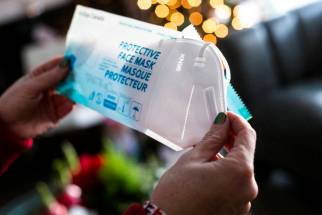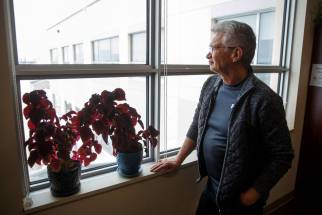Manitoba ready to let her rip after two years of tiptoeing around COVID
Read this article for free:
or
Already have an account? Log in here »
To continue reading, please subscribe:
Monthly Digital Subscription
$0 for the first 4 weeks*
- Enjoy unlimited reading on winnipegfreepress.com
- Read the E-Edition, our digital replica newspaper
- Access News Break, our award-winning app
- Play interactive puzzles
*No charge for 4 weeks then price increases to the regular rate of $19.00 plus GST every four weeks. Offer available to new and qualified returning subscribers only. Cancel any time.
Monthly Digital Subscription
$4.75/week*
- Enjoy unlimited reading on winnipegfreepress.com
- Read the E-Edition, our digital replica newspaper
- Access News Break, our award-winning app
- Play interactive puzzles
*Billed as $19 plus GST every four weeks. Cancel any time.
To continue reading, please subscribe:
Add Free Press access to your Brandon Sun subscription for only an additional
$1 for the first 4 weeks*
*Your next subscription payment will increase by $1.00 and you will be charged $16.99 plus GST for four weeks. After four weeks, your payment will increase to $23.99 plus GST every four weeks.
Read unlimited articles for free today:
or
Already have an account? Log in here »
Hey there, time traveller!
This article was published 11/03/2022 (1370 days ago), so information in it may no longer be current.
The most striking part of the government’s response to the first handful of COVID-19 cases in Manitoba two years ago is the extreme measures that were taken.
It was clearly an overreaction to shut down schools, day cares, gyms, bars and restaurants and impose strict capacity limits in public places when there were just over 100 cases of COVID-19 in the province. It wasn’t the wrong decision at the time; the government just didn’t know better. Most of the decisions back then were driven by uncertainty.
Knowing what we know today, the most effective response at the time would probably have been to impose a mandatory mask rule in all public places, enforce self-isolation and travel restrictions, put moderate capacity limits in public places and build fortresses around long-term care facilities to protect the most vulnerable seniors. There was no need to shut everything down, at least not during the first wave when the original strain of the SARS-CoV-2 virus was far less contagious than it is now.
It wasn’t the wrong decision at the time; the government just didn’t know better.
Mask use two years ago wasn’t seen as an option, though. Public health officials, including at the World Health Organization, were still rejecting them as effective tools to reduce transmission in the public. They didn’t know a lot about the virus in early 2020. They still believed only symptomatic people could spread it and had no idea it was airborne.
“This virus spreads almost exclusively through close contact to infected individuals who are showing symptoms of infection,” Dr. Brent Roussin, the chief provincial public health officer said on March 12, 2020, the day the province announced the first case of COVID-19 in Manitoba.
We now know that’s not the case.
However, the scientific evidence on SARS-CoV-2 was evolving rapidly at the time. Just two months earlier, scientists weren’t even sure if it could spread between humans.
The overreaction and draconian measures aside, there is one principle the government followed two years ago that is sadly missing from today’s approach: the province no longer errs on the side of caution when making public health decisions. Politicians may have gone overboard during the first wave, most of which can be explained by the fact governments and scientists knew so little about the virus, including how to manage it. But the government felt it had a responsibility to ensure adequate protective measures were in place. It no longer does, even though Manitoba still has 417 COVID-19 patients in hospital, including 23 in intensive care units.
There is one principle the government followed two years ago that is sadly missing from today’s approach: the province no longer errs on the side of caution when making public health decisions.
“What we’re trying to do here is to lessen the impact by proactive measures to make sure that our system stands up above all others,” then-premier Brian Pallister said the day after Manitoba’s first case of COVID-19 was announced. It was also the day the province decided to suspend in-class learning in public schools for three weeks.
“We’re making sure that we do everything we can to protect the health and well-being of people here and we’re trying to do that in a proactive way that is not alarmist, that does not instill fear but rather instills a sense I hope of… confidence.”
If the government took that same proactive approach today, it would maintain the indoor mask mandate, make self-isolation mandatory for those who test positive and keep proof-of-vaccination rules in place, including for health care workers, at least until COVID-19 hospital cases are under control. It may turn out we don’t need any of those measures, the last of which (masks) are scheduled to be lifted March 15. However, public heath isn’t about trying to do as little as possible and hoping it all works out. It’s about taking proactive measures that are proportionate to the risks.
“We can err on the side of caution or err on the side of delay,” Pallister said when his government decided to close schools, just a few hours after Roussin said that morning schools would not be closed. “After discussions, we’ve decided to err on the side of caution.”
The Tory government doesn’t err on the side of caution anymore when it comes to COVID-19. Maybe it’s because of political and public pressure, or just sheer exhaustion – or all three. Whatever the case, the pendulum has swung from taking cautious, calculated steps based on evidence and public health projections to throwing all caution to the wind and hoping for the best.
If the government took that same proactive approach today, it would maintain the indoor mask mandate, make self-isolation mandatory for those who test positive and keep proof-of-vaccination rules in place.
History shows that’s not usually the best course of action.
tom.brodbeck@freepress.mb.ca

Tom has been covering Manitoba politics since the early 1990s and joined the Winnipeg Free Press news team in 2019.
Our newsroom depends on a growing audience of readers to power our journalism. If you are not a paid reader, please consider becoming a subscriber.
Our newsroom depends on its audience of readers to power our journalism. Thank you for your support.








